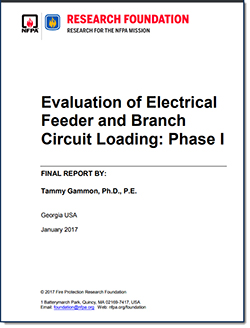
This month we'd like to bring your attention to a Fire Protection Research Foundation report on the NFPA website, called Evaluation of Electrical Feeder and Branch Circuit Loading: Phase 1, authored by Tammy Gammon, PhD., P.E.
The Introduction:
 Interest has been growing in recent years to investigate and clarify the degree to which the feeder and branch circuit load design requirements in NFPA 70, National Electrical Code® (NEC®) need to be adjusted based on the increasing pace of technological innovation along the entire span of the electrical power chain. Interest has been growing in recent years to investigate and clarify the degree to which the feeder and branch circuit load design requirements in NFPA 70, National Electrical Code® (NEC®) need to be adjusted based on the increasing pace of technological innovation along the entire span of the electrical power chain.
There are multiple factors driving this issue and supporting the need to address this topic. For example, today's Energy Codes are driving down the electrical load presented by end use equipment and thus load growth assumptions that justify spare capacity should be re-examined. In addition, larger than necessary transformers that supply power to feeder and branch circuits expose unnecessary flash hazard to electricians working on live equipment.
This report summarizes a Phase I effort to develop a data collection plan to provide statistically significant load data for a variety of occupancy and loading types to provide a technical basis for considering revisions to the feeder and branch circuit design requirements in the National Electrical Code®. This initial effort has an emphasis on general commercial (office) occupancies, and the deliverables provide a review of the literature, and clarify the key elements of a data collection plan in support of a potential second phase (not included in the scope of this effort).
Visit the NFPA website here, or click on the image, to read the report.
|
|

